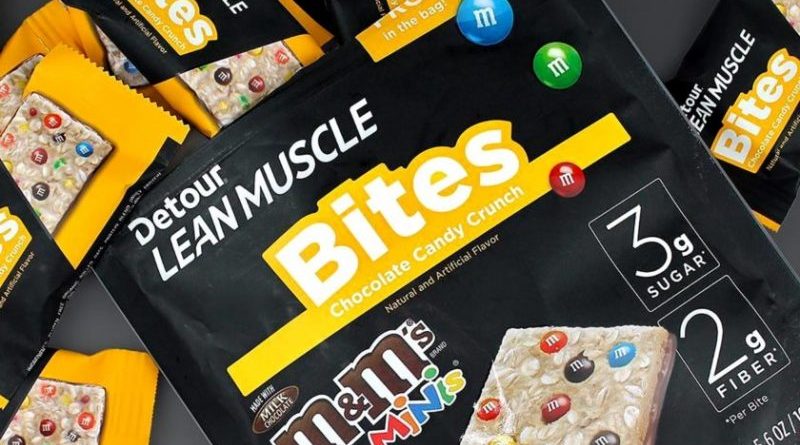Brand Partnerships Continue with Detour and M&M’s
The supplement industry is starting to dabble and work with brands outside our niche – and that’s a great thing! While brand partnerships are put in place to benefit both parties, it’s my opinion that the supplement industry needs these brand partnerships more than the partnering business.
For years the supplement industry, in my opinion, has been boring. There really hasn’t been anything new coming out other than me too and copycat products/formulations. There hasn’t been much innovation or thinking outside the box. But recently there have been a few brands that looked at consumer demands and noticed that consumers are looking for better snack items as well as better tasting flavor profiles.

While flavors are nothing like they were back in the ‘90s, there is still some room for improvement. If you were around and using supplements back in the ‘90s you would remember the horrid tasting protein bars and powders that were available. Maybe it’s for that reason that we like many of the flavors available today but when a non-supplement user tries a product, they hate the taste. We are probably just so used to choking down a disgusting product that any improvement makes it seem like we are cheating on our diet.
There are a few brands in 2018 who went out and secured brand partnerships that I feel did a world of good for their supplement brand. BSN went out and partnered with Cold Stone Creamery to introduce some ice cream flavored protein powders (which are actually extremely delicious) as well as Ghost who went out and worked with brands such as Warheads to launch new flavors of their pre-workout.
What Are Brand Partnerships?

Brand partnerships refer to collaborative relationships between two or more brands for mutual benefit. These partnerships are formed with the goal of achieving common objectives and leveraging each other’s strengths. Brand partnerships can take various forms, including co-branded products, joint marketing campaigns, co-sponsored events, or other collaborative efforts.
Key aspects of brand partnerships include:
- Mutual Benefit: Both brands involved in the partnership should stand to gain value. This could be through increased brand visibility, access to new markets, shared resources, or enhanced credibility.
- Shared Values: Successful brand partnerships often involve brands that share similar values or target the same audience. This alignment helps create a more cohesive and authentic collaboration.
- Co-Creation: Partnerships may involve the creation of co-branded products or services, combining the expertise and offerings of each brand. This can lead to unique and appealing offerings for consumers.
- Marketing Collaborations: Joint marketing efforts, such as co-sponsored events, social media campaigns, or advertising initiatives, can amplify the reach and impact of both brands.
- Cross-Promotion: Brands in a partnership may promote each other’s products or services, expanding their reach to each other’s customer bases.
- Strategic Alliances: Some brand partnerships go beyond short-term collaborations and involve long-term strategic alliances. This could include partnerships with influencers, other businesses, or industry associations.
Brand partnerships are a strategic approach for brands to tap into new markets, increase brand awareness, and enhance their overall competitiveness. These collaborations can be particularly effective when they create a win-win situation for all parties involved.
Can Forming a Partnership Between Brands Grow Your Business?
Yes, forming partnerships between brands can indeed contribute to the growth of businesses. Such collaborations offer several potential benefits that can positively impact the involved brands. Here are some ways in which brand partnerships can contribute to business growth:
- Expanded Reach and Audience: Partnering with another brand allows for access to a broader audience. This can be especially beneficial if the partner brand has a different but complementary customer base. It helps in reaching new markets and potential customers that may not have been accessible otherwise.
- Increased Brand Visibility: Joint marketing efforts, co-branded products, and shared promotional activities can lead to increased visibility for both brands. This heightened exposure can attract more attention from consumers and enhance brand recognition.
- Cost-Effective Marketing: Collaborative marketing efforts can be more cost-effective than individual campaigns. By sharing resources and costs, brands can achieve a greater impact without a proportional increase in expenses.
- Enhanced Credibility: Partnering with a reputable brand can boost the credibility and trustworthiness of both parties. Consumers may perceive a higher level of trust in a product or service that is associated with well-established brands.
- Innovation and Product Development: Collaborative partnerships often involve sharing expertise and resources. This can lead to innovative product or service offerings that capitalize on the strengths of each brand. Co-created products may appeal to a wider audience and drive sales growth.
- Access to New Markets: Partnering with a brand that operates in different geographical locations or markets can facilitate entry into those areas. This can be especially advantageous for businesses looking to expand globally.
- Cross-Promotion Opportunities: Brands can leverage each other’s customer bases through cross-promotion. This can lead to increased customer loyalty and repeat business.
- Strategic Alliances: Long-term partnerships can create strategic alliances that provide ongoing benefits. This might include joint research and development, shared distribution channels, or collaborative efforts in addressing industry challenges.

It’s important to note that successful partnerships require careful planning, clear communication, and alignment of goals. Not all brand partnerships may lead to business growth, and compatibility between brands is crucial for a fruitful collaboration. Additionally, businesses should consider factors such as brand reputation, values, and target audience compatibility when forming partnerships.
Are There Any Downsides to Doing This?
While forming brand partnerships can offer numerous benefits, there are also potential downsides and challenges associated with such collaborations. It’s important for businesses to be aware of these factors and carefully evaluate whether a partnership is the right strategic move. Here are some potential downsides:
- Brand Alignment Issues: If there is a lack of alignment in values, target audience, or overall brand image between the partnering brands, it can lead to confusion and negative perception among consumers.
- Dependency Risks: Over-reliance on a partner can pose risks, especially if one brand becomes heavily dependent on the success or stability of the other. Changes in the partner’s business or strategy could impact the dependent brand.
- Conflict of Interest: Conflicts may arise if there are competing interests or goals between the partnering brands. This can lead to disagreements on strategies, marketing approaches, or other critical aspects of the partnership.
- Legal and Contractual Challenges: Failure to establish clear and comprehensive partnership agreements can result in legal and contractual issues. Ambiguities or misunderstandings in contracts may lead to disputes that can harm the relationship.
- Financial Implications: While partnerships can be cost-effective, there are financial considerations, including shared expenses and potential investments. Financial imbalances or disagreements on resource allocation can create tension.
- Cannibalization of Brand Identity: Co-branding may dilute the unique identity of each brand, especially if consumers perceive a mismatch or confusion in the joint offerings. Striking the right balance is crucial to maintain brand integrity.
- Communication Challenges: Ineffective communication between partner brands can lead to misunderstandings, delays, and suboptimal execution of collaborative efforts. Regular and transparent communication is essential for successful partnerships.
- Market Saturation: If too many brands in the same industry engage in similar partnerships, it may lead to market saturation and reduced impact. Overused collaboration strategies may also result in diminishing returns.
- Risk of Negative Publicity: Negative publicity affecting one partner may spill over to the other. Issues such as controversies, scandals, or public relations mishaps involving one brand can impact the reputation of both.
- Integration Challenges: Integrating different business processes, technologies, or cultures between partnering brands can be challenging. Misalignment in operational aspects can hinder the smooth execution of collaborative initiatives.
It’s crucial for businesses to conduct thorough due diligence, assess potential risks, and establish clear guidelines and communication channels before entering into brand partnerships. Addressing these challenges proactively can help mitigate risks and contribute to the success of collaborative efforts.
Why Brand Partnerships Work
Using the examples I supplied above, here is why this works for the supplement industry (and why it doesn’t necessarily help the other partner). The supplement industry has a target on its back – for several reasons. Many people don’t trust the supplement industry due to what the media says about it. Yes, some of it is true, but not all brands out there today are coming out with tainted products that don’t meet labels claims or the various other issues that have surfaced over the last few years.
The supplement industry needs a mass market image to go along with its brand to draw in new consumers and gain trial on their products. If someone never tried protein powder before but they found out that Cold Stone Creamery has multiple flavors of protein powder under the BSN line, those ice cream consumers might be more willing to give it a try and become loyal consumers to the brand. The same thing goes with Ghost and their brand partnerships with Warheads. If people love eating candy such as Warheads, if they find out there is a pre-workout of that specific flavor and the individual works out, they are more likely to give the Ghost pre-workout a try.
Click here to continue reading…


*Disclosure: This article may contain affiliate links or ads, which means we earn a small commission at no extra cost to you if you make a purchase through these links. These commissions help support the operation and maintenance of our website, allowing us to continue producing free valuable content. Your support is genuinely appreciated, whether you choose to use our links or not. Thank you for being a part of our community and enjoying our content.
PLEASE CONSIDER SHARING THIS ON YOUR SOCIAL MEDIA TO HELP OTHERS LEARN MORE ABOUT THIS TOPIC.





